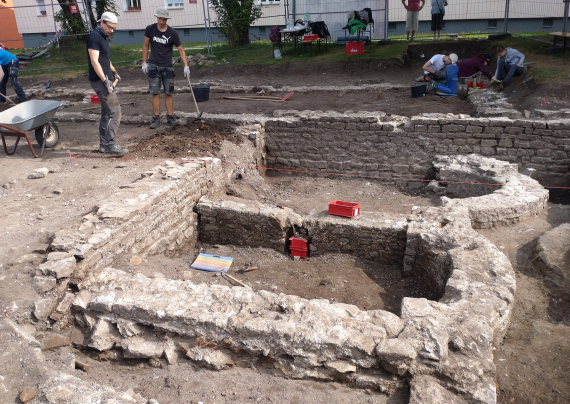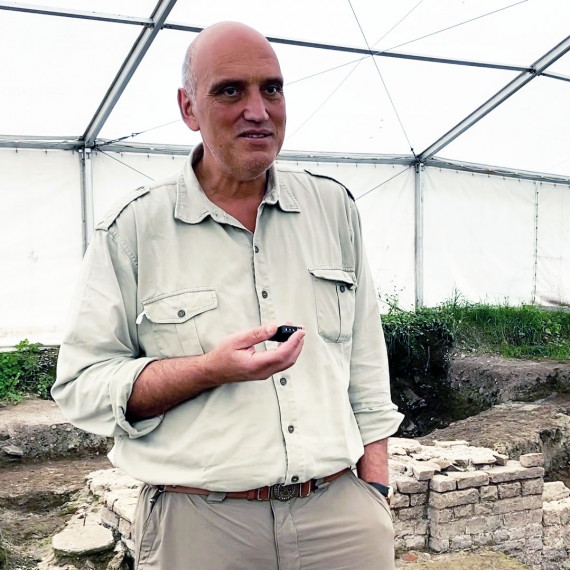Research and excavation
“Insula 1” Research Project
A cooperative project with Ludwig-Maximilians-Universität München (LMU Munich) that is due to run for several years under the direction of Professor Salvatore Ortisi was launched in the summer of 2019. The object of research is Cambodunum’s settlement history.
At the western edge of a Roman residential quarter known as “Insula 1”, archaeologists are examining Cambodunum’s only dwelling that was not destroyed by modern development.
 Aerial view of the excavation area "Insula 1" 2022, © APC
Aerial view of the excavation area "Insula 1" 2022, © APC
Excavation findings in 2022
At the Archaeological Park Cambodunum, an extraordinary discovery was made that is unique in southern Germany: Roman stone structures that came to light during excavations are among the oldest in Germany.
 Archaeology students at work: The excavation team of the Ludwig-Maximilians-University of Munich uncovers a private bathing complex. © APC
Archaeology students at work: The excavation team of the Ludwig-Maximilians-University of Munich uncovers a private bathing complex. © APCIn Kempten, archaeologists excavated an impressive residential house with intact screed floors, private thermal baths, and mural paintings, evidence of Cambodunum’s significance as a Roman civil settlement in Bavaria.
Together with the School of Archaeology of the Roman Provinces at LMU Munich and the Bavarian Office for the Conservation of Historical Monuments, we have been working since 2019 at the site known as “Insula 1” in the Archaeological Park Cambodunum, where we have succeeded in excavating and scientifically examining two buildings belonging to a central block of houses in the Roman town.
 Excavation director Prof. Dr. Salvatore Ortisi of the Ludwig-Maximilians-University Munich, © APC
Excavation director Prof. Dr. Salvatore Ortisi of the Ludwig-Maximilians-University Munich, © APCAs Prof. Ortisi from the LMU Munich says, “Cambodunum-Kempten represents a first-class research location of particular importance for the archaeology of the Roman provinces and for the LMU Munich, because research can be combined here in optimal fashion with the communication and permanent presentation of the results of this research.”
The city of Kempten is fortunate that the core area associated with its Roman past was not destroyed by modern development but has been preserved as an archaeological monument directly beneath the turf. According to Dr Maike Sieler, urban archaeologist and director of the Archaeological Park Cambodunum, “Cooperation with the LMU Munich enables us to press forward with the scientific examination of the Roman town of Cambodunum and, in the future, present the findings in situ as new museum highlights in the Archaeological Park.”
The cooperative research project’s current excavation findings were presented in 2022. An entire residential house of over 800 square metres was uncovered in the centre of the Roman town. The excavated remains of this Roman stone structure are among the oldest in Germany.
 Dr Maike Sieler, urban archaeologist and director of the Archaeological Park Cambodunum, © APC
Dr Maike Sieler, urban archaeologist and director of the Archaeological Park Cambodunum, © APCWhat is remarkable is the good condition of the finds: in addition to intact screed floors and floor heating, we would like to emphasise the small private thermal baths and extant mural paintings. “We have come upon a key section of Roman Cambodunum’s main residential area – well-preserved in its entirety – a one-of-a-kind find in southern Germany. It is impressive evidence of Cambodunum’s significance as a hub in the early phase of Raetia’s provincialisation and at the beginning of Bavaria’s Roman era,” says Dr Sieler.
The residential blocks located directly opposite the large public buildings, such as the forum with basilica and governor’s palace, are known as “insulae”. These were home to the Roman town’s most important families. It is evident that over time the prestigious residential buildings that have now been excavated in “Insula 1” were, in various cases, remodelled or modified for different uses. These changes reflect how living, working, and dwelling blended and mixed in one of the most thriving towns north of the Alps.
As Prof. Ortisi puts it: “Cambodunum-Kempten is an outstanding example of a planned Roman town. Here we have a first-rate opportunity to reconstruct Rome’s development and urbanisation of areas north of the Alps. These Celtic Roman beginnings represent the origins of many of our modern cities and had a vital influence on the cultural development of southern Germany.”
